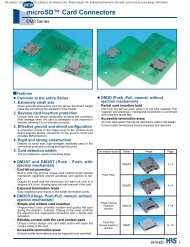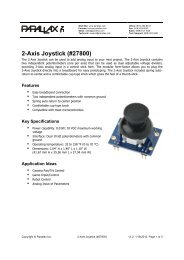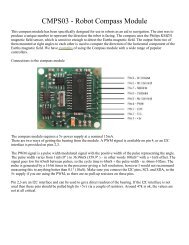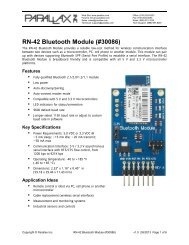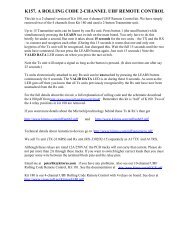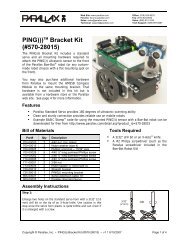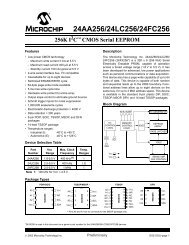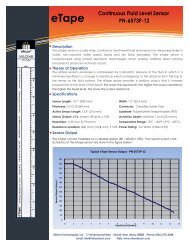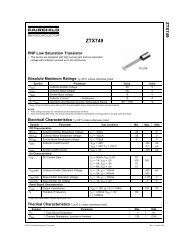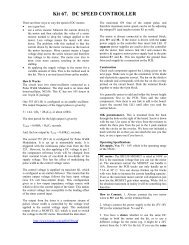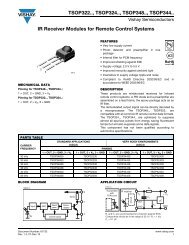LM2940/LM2940C 1A Low Dropout Regulator - Avtanski.com ...
LM2940/LM2940C 1A Low Dropout Regulator - Avtanski.com ...
LM2940/LM2940C 1A Low Dropout Regulator - Avtanski.com ...
You also want an ePaper? Increase the reach of your titles
YUMPU automatically turns print PDFs into web optimized ePapers that Google loves.
<strong>LM2940</strong>/<strong>LM2940</strong>C<br />
Application Hints (Continued)<br />
parallel an aluminum electrolytic with a solid Tantalum, with<br />
the total capacitance split about 75/25% with the Aluminum<br />
being the larger value.<br />
If two capacitors are paralleled, the effective ESR is the<br />
parallel of the two individual values. The “flatter” ESR of the<br />
Tantalum will keep the effective ESR from rising as quickly at<br />
low temperatures.<br />
HEATSINKING<br />
A heatsink may be required depending on the maximum<br />
power dissipation and maximum ambient temperature of the<br />
application. Under all possible operating conditions, the junction<br />
temperature must be within the range specified under<br />
Absolute Maximum Ratings.<br />
To determine if a heatsink is required, the power dissipated<br />
by the regulator, P D , must be calculated.<br />
The figure below shows the voltages and currents which are<br />
present in the circuit, as well as the formula for calculating<br />
the power dissipated in the regulator:<br />
I IN =I L ÷I G<br />
P D =(V IN −V OUT )I L +(V IN )I G<br />
FIGURE 2. Power Dissipation Diagram<br />
00882237<br />
The next parameter which must be calculated is the maximum<br />
allowable temperature rise, T R (max). This is calculated<br />
by using the formula:<br />
T R (max) = T J (max) − T A (max)<br />
where: T J (max) is the maximum allowable junction temperature,<br />
which is 125˚C for <strong>com</strong>mercial<br />
grade parts.<br />
T A (max) is the maximum ambient temperature<br />
which will be encountered in the<br />
application.<br />
Using the calculated values for T R (max) and P D , the maximum<br />
allowable value for the junction-to-ambient thermal<br />
resistance, θ (JA) , can now be found:<br />
θ (JA) =T R (max)/P D<br />
IMPORTANT: If the maximum allowable value for θ (JA) is<br />
found to be ≥ 53˚C/W for the TO-220 package, ≥ 80˚C/W for<br />
the TO-263 package, or ≥174˚C/W for the SOT-223 package,<br />
no heatsink is needed since the package alone will<br />
dissipate enough heat to satisfy these requirements.<br />
If the calculated value for θ (JA) falls below these limits, a<br />
heatsink is required.<br />
HEATSINKING TO-220 PACKAGE PARTS<br />
The TO-220 can be attached to a typical heatsink, or secured<br />
to a copper plane on a PC board. If a copper plane is<br />
to be used, the values of θ (JA) will be the same as shown in<br />
the next section for the TO-263.<br />
If a manufactured heatsink is to be selected, the value of<br />
heatsink-to-ambient thermal resistance, θ (H−A) , must first be<br />
calculated:<br />
θ (H−A) = θ (JA) − θ (C−H) − θ (J−C)<br />
Where: θ (J−C) is defined as the thermal resistance from the<br />
junction to the surface of the case. A value of<br />
3˚C/W can be assumed for θ (J−C) for this<br />
calculation.<br />
θ (C−H) is defined as the thermal resistance between<br />
the case and the surface of the heatsink. The<br />
value of θ (C−H) will vary from about 1.5˚C/W to<br />
about 2.5˚C/W (depending on method of attachment,<br />
insulator, etc.). If the exact value is<br />
unknown, 2˚C/W should be assumed for<br />
θ (C−H) .<br />
When a value for θ (H−A) is found using the equation shown,<br />
a heatsink must be selected that has a value that is less than<br />
or equal to this number.<br />
θ (H−A) is specified numerically by the heatsink manufacturer<br />
in the catalog, or shown in a curve that plots temperature rise<br />
vs power dissipation for the heatsink.<br />
HEATSINKING TO-263 AND SOT-223 PACKAGE PARTS<br />
Both the TO-263 (“S”) and SOT-223 (“MP”) packages use a<br />
copper plane on the PCB and the PCB itself as a heatsink.<br />
To optimize the heat sinking ability of the plane and PCB,<br />
solder the tab of the package to the plane.<br />
Figure 3 shows for the TO-263 the measured values of θ (JA)<br />
for different copper area sizes using a typical PCB with 1<br />
ounce copper and no solder mask over the copper area used<br />
for heatsinking.<br />
00882238<br />
FIGURE 3. θ (JA) vs. Copper (1 ounce) Area for the<br />
TO-263 Package<br />
As shown in the figure, increasing the copper area beyond 1<br />
square inch produces very little improvement. It should also<br />
be observed that the minimum value of θ (JA) for the TO-263<br />
package mounted to a PCB is 32˚C/W.<br />
As a design aid, Figure 4 shows the maximum allowable<br />
power dissipation <strong>com</strong>pared to ambient temperature for the<br />
TO-263 device (assuming θ (JA) is 35˚C/W and the maximum<br />
junction temperature is 125˚C).<br />
www.national.<strong>com</strong> 14




